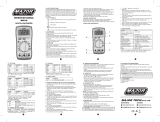DVM92 GB 1
DVM92 -- Multifunctional Digital Multimeter with 3 ½ Digit LCD
1. Introduction
Your DVM92 is a professional digital multimeter with a 3 ½ digit LCD display. It is ideally suited
for professional, academic and home applications. The device is equipped with the latest in IC
and display technology. Thanks to this technology, the DVM92 will provide you with precise and
reliable measurements for years to come.
The DVM92 measures DC and AC voltage, DC and AC current, resistance and continuity. The
user can also test diodes and transistors (hFE).
1.1. Warning
Be very careful when performing measurements as improper use of this device may result in
serious injuries or even death. Take all usual precautions for working with electrical circuits and
mind the safety prescriptions listed below. Do not use this device if you are unfamiliar with
electrical circuits and testing procedures.
This device is not intended for commercial or industrial use.
1.2. Safety Prescriptions
This multimeter was designed to ensure the safest operation possible. Nevertheless, safe
operation mainly depends on you, the user. Respect the following safety prescriptions :
• Never apply more than 1000VDC or 750Vrms AC between an input jack and ground.
• Use extreme caution when working with voltages in excess of 60VDC or 30Vrms AC.
• Always discharge the filter capacitors in the power supply circuit under test before attaching
the test leads.
• Never connect a voltage source to the DVM92 when it is in current (DCA or ACA) mode,
resistance or continuity mode.
• Always turn off the power and disconnect the test leads prior to replacing the battery or fuse.
• The user should only operate the multimeter when the back cover is in place and securely
fastened.
• When carrying out measurements on TVs or switching power circuits, you should always
remember that high voltage pulses may occur at the test points. These pulses may damage
the meter.
1.3. Maintenance
Your DVM92 is an example of superior design and craftsmanship. The following suggestions
will help you keep the device in perfect working order :
• Do not expose the device to water. Wipe it dry immediately if it should get wet.
• Use and store the multimeter under normal temperatures. Extreme temperatures may
shorten the life of the device or damage the battery.
• Handle the multimeter with care. Dropping it may damage the circuit boards or the housing
and may cause the DVM92 to malfunction.
• Replace an old or weak battery with a fresh one of the required size and type.
Remove the battery during long periods of inactivity. This will protect the multimeter from
possible leakage.
• Disconnect the test probes prior to opening the housing.







